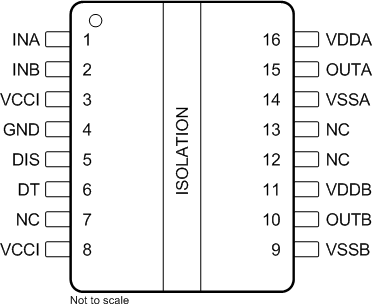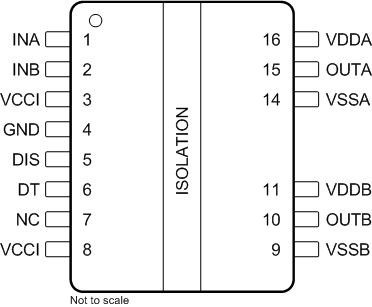JAJSG66E September 2018 – November 2024 UCC21540 , UCC21540A , UCC21541 , UCC21542
PRODUCTION DATA
- 1
- 1 特長
- 2 アプリケーション
- 3 概要
- 4 デバイス比較表
- 5 ピン構成および機能
- 6 仕様
- 7 パラメータ測定情報
- 8 詳細説明
-
9 アプリケーションと実装
- 9.1 アプリケーション情報
- 9.2 代表的なアプリケーション
- 10電源に関する推奨事項
- 11レイアウト
- 12デバイスおよびドキュメントのサポート
- 13改訂履歴
- 14メカニカル、パッケージ、および注文情報
パッケージ・オプション
デバイスごとのパッケージ図は、PDF版データシートをご参照ください。
メカニカル・データ(パッケージ|ピン)
- DWK|14
- DW|16
サーマルパッド・メカニカル・データ
- DW|16
発注情報
5.1 ピン構成および機能
 図 5-1 DW パッケージ16 ピン SOIC上面図
図 5-1 DW パッケージ16 ピン SOIC上面図 図 5-2 DWK パッケージ14 ピン SOIC上面図
図 5-2 DWK パッケージ14 ピン SOIC上面図表 5-1 ピンの機能
| ピン | タイプ (1) | 説明 | |
|---|---|---|---|
| 名称 | 番号 | ||
| DIS | 5 | I | High にアサートすると両方のドライバ出力はディセーブルされ、Low に設定するとイネーブルされます。このピンを使わない場合、ノイズ耐性を向上させるためにグランドに接続することを推奨します。離れた場所にあるマイクロコントローラに接続するときは、DIS ピンに近接して配置した約 1nF の低 ESR/ESL コンデンサを使ってバイパスします。 |
| DT | 6 | I | DT ピンの設定:
|
| GND | 4 | P | 1 次側のグランド基準。1 次側のすべての信号はこのグランドを基準とします。 |
| INA | 1 | I | A チャネルの入力信号。INA 入力は TTL/CMOS 互換の入力スレッショルドを持っています。このピンは、オープンのままにすると内部で Low にプルされます。このピンを使わない場合、ノイズ耐性を向上させるためにグランドに接続することを推奨します。 |
| INB | 2 | I | B チャネルの入力信号。INB 入力は TTL/CMOS 互換の入力スレッショルドを持っています。このピンは、オープンのままにすると内部で Low にプルされます。このピンを使わない場合、ノイズ耐性を向上させるためにグランドに接続することを推奨します。 |
| NC | 7 | — | 内部接続なしこのピンはオープンのまま、VCCI に接続、GND に接続のいずれかにできます。 |
| NC | 12 | — | 内部接続なし。必要に応じて、ドライバ A からドライバ B までの沿面距離を最大にするため、フローティングのままにしておくことを推奨します。 SOIC-14 DWK パッケージの場合、ピン 12 とピン 13 は除去されています。 |
| 13 | |||
| OUTA | 15 | O | ドライバ A の出力。A チャネルの FET または IGBT のゲートに接続します。 |
| OUTB | 10 | O | ドライバ B の出力。B チャネルの FET または IGBT のゲートに接続します。 |
| VCCI | 3 | P | 1 次側の電源電圧。本デバイスにできる限り近づけて配置した低 ESR/ESL コンデンサを使って GND に対して局所的にデカップリングします。 |
| VCCI | 8 | P | このピンはピン 3 と内部で短絡しています。 ピン 8~4 の代わりにピン 3~4 をバイパスすることを推奨します。 |
| VDDA | 16 | P | ドライバ A の 2 次側電源。本デバイスにできる限り近づけて配置した低 ESR/ESL コンデンサを使って VSSA に対して局所的にデカップリングします。 |
| VDDB | 11 | P | ドライバ B の 2 次側電源。本デバイスにできる限り近づけて配置した低 ESR/ESL コンデンサを使って VSSB に対して局所的にデカップリングします。 |
| VSSA | 14 | P | 2 次側のドライバ A のグランド。2 次側の A チャネルのグランド リファレンス電圧。 |
| VSSB | 9 | P | 2 次側のドライバ B のグランド。2 次側の B チャネルのグランド リファレンス電圧。 |
(1) P = 電源、I = 入力、O = 出力